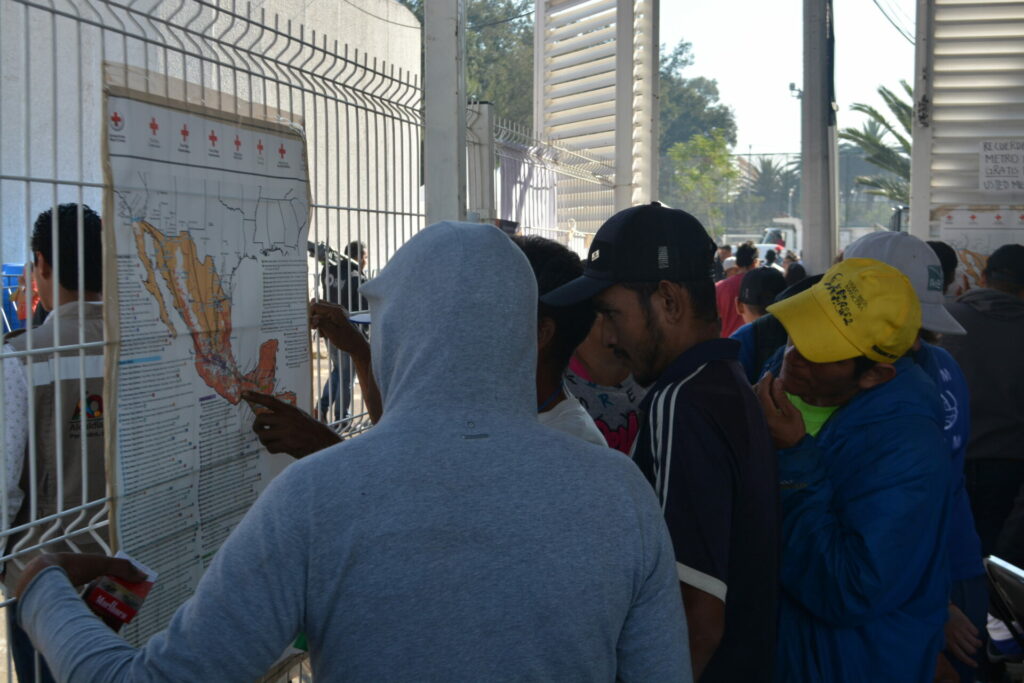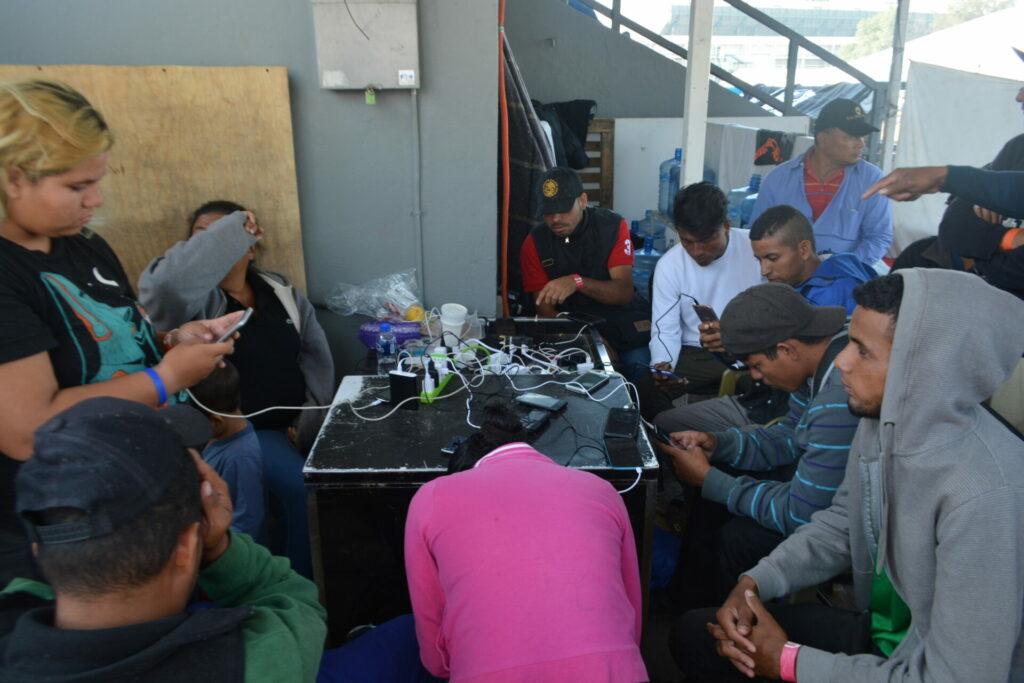It was early October 2018 in Honduras, a northern Central American region strongly affected by violence, poverty, and climate deterioration, when an event that would change migration dynamics in the entire continent occurred in the city of San Pedro Sula. The news was everywhere. The rumor expanded with the speed of light inside migrants’ knowledge networks and spaces: a collective migrant caravan was being formed, ready to walk the long route through Central America and Mexico to try to cross the border to the United States. As it is one of the most dangerous migration paths in the world, largely controlled by criminal organizations and corrupt state agents, walking together as a group seemed like a proper and safe decision.
Social media platforms played a crucial role in disseminating information about the caravan. According to a situation described by anthropologist Valentina Glockner Fagetti, for example, this was how Norman, a young student in Honduras, found out about it. Norman remembers that the rumor about the migrant caravan traveled rapidly in WhatsApp chats and Facebook groups. Suddenly, most of his classmates stopped attending classes to join the migrant group, and it didn’t take long for Norman also to pack his things and leave.1 Many other people did the same. On October 12, around 200 persons gathered at the San Pedro Sula bus station. As the migrant caravan proceeded along the long route to Mexico, more than 12,000 people joined in at different locations,2 also from neighboring countries like El Salvador and Guatemala.
In the blink of an eye, the migrant caravan mutated into a vast media-relevant event regionally and worldwide. How did an open, spontaneous call to migrate in a group change abruptly into such a large caravan of people? As this was a complex phenomenon, the reasons are diverse; nevertheless, we can argue that the use of digital communications and social media channels among migrants to disseminate knowledge and migration practices jumpstarted and accelerated its growth. The migrants’ knowledge in this case consisted of a whole set of shared experiences, networks, and organizational activities for a long journey, which the migrants shared via digital platforms.

Carrying Out the Migrant Caravan as a Media Event
Different media outlets in Central America, Mexico, and the US started covering the migrant caravan live, thereby transforming themselves into disseminators of the phenomenon and motivating other persons to join. It didn’t take long for then-US President Donald Trump to begin tweeting, warning people in the caravan to turn back and threatening to retaliate if governments in the region did not stop the migration movement. He also spread false and misleading information, suggesting, among other things, that some of the migrants were criminals and dangerous individuals.3 The US midterm elections were on the horizon, so Trump politicized the topic to mobilize his supporters.
Before the caravan started, posts circulated on digital media platforms informing those interested in joining that people would gather on October 12 at the San Pedro Sula bus station.4 This information spread like wildfire through private networks and public social media groups, and people joined in a matter of hours and days. Digital media platforms enabled affective dynamics to factor in to the phenomenon,5 so feelings of solidarity and empowerment rapidly permeated much of the communication.
It’s relevant to consider that Hondurans, Salvadorans, and Guatemalans have relatives and friends who have previously migrated to the US, so the social networks and affective relationships that arose from these connections became nodes through which information flowed.6 Migrants already living in the US shared advice for walking the long route to North America more safely, including itinerary recommendations, contacts who could offer help or information about available transportation, and shelter on the road. Communication took place mainly via phone calls, SMS messages, and social media chats. In this way, valuable migrant knowledge acquired by earlier migrants circulated rapidly through media channels. Digital networks became tools for sharing and mobilizing multiple migratory practices.
Social media platforms were crucial for deciding on meeting points and migration routes, which involved a high level of organizational complexity. Some WhatsApp groups, for example, were divided into cities and departments, with the place and date of departure indicated in the chat name.7 Members of these groups recommended what participants should bring for the journey or provided information about risky areas and border checkpoints. Yet social media chats were not protected from individuals writing xenophobic messages against migrants. Hence, group members designed filters or opened new groups to make communication more secure.8
These organizational dynamics were further complicated by the interaction among social media platforms. Migrants placed open calls in Facebook groups, later publishing links to join specific WhatsApp chats there as well.9 Social media channels that had previously been utilized to organize collective travels also remained open or were reactivated once migrants planned new journeys. Given all these factors, it is not surprising that most people heard about the migrant caravan through social networks.10

Mediated Migrant Dynamics and Practices
The above-mentioned media-related practices11 and shared knowledge were also fundamental to the dynamics within the caravan for decision-making and communication with third parties. During the long journey through Mexican territory, migrants organized assemblies to vote on preferred routes; they established internal brigades to provide security within the camps, mainly for children traveling inside the groups; and they appointed speakers to represent them to journalists, governmental authorities, and NGO delegates.12 Elected spokespersons sometimes received a notebook, a megaphone, and a cell phone to coordinate specific groups within the caravan.13 Migrants used networked technologies to manage and carry out these processes effectively. In that sense, digital communications allowed for the migration dynamics to continually and rapidly be reorganized in response to new conditions.
These same media-related practices enabled migrants to take political action. Many shared their testimonies directly with international media outlets, wrote press statements, and gave press conferences. In this way, migrants established a direct dialogue with traditional media platforms, defying the stereotypical and dominant image of the migrant as a scared, vulnerable individual surrounded by police and migration authorities in legacy media.14 Instead, the caravan members presented themselves as politically active individuals and groups, dancing and chanting songs, waving flags, playing sports, and generating an internal organization for distributing food and arranging shelter. These empowerment processes allowed caravaneras and caravaneros to own their stories and representations.
Nevertheless, this visibility also had a downside, exposing migrants to different vulnerabilities and discrimination. For example, they frequently were the targets of hate speech on social media platforms. Along with racist and xenophobic comments against migrants, pictures and videos were taken out of context and distributed to convey false ideas, or “fake news,” about the caravan. In this sense, the same digital media that facilitated the organization and expansion of the caravan also aided its enemies in organizing protests against migrants along the route north. Conversely, many other digital media users expressed solidarity with the migration movement, assembling brigades or bringing clothes and food to the shelters. Thus, the affective responses to the migrant caravan were polarized, with expressions of solidarity and empathy juxtaposed with expressions of fear and hate comprising the main components of public communication around the topic.
Changing Migrant Paradigms
The long journey of the Central American migrant caravan took up the final months of 2018 and profoundly changed the migration dynamics and politics in the region. As caravaneras and caravaneros walked through Mexican territory, they divided into small groups. Many reached the city of Tijuana on the Mexican-US border, and others took alternative routes or returned to their towns of origin. Some migrants were successful and reached the US; others stayed in Mexico. Although the routes and destinations diverged, this massive migration movement had a lasting influence, prompting many other migrants to attempt to travel in caravans.
The knowledge that migrants were able to share via digital communications played a vital role in the formation, development, and organization of the migrant caravan. Media-related dynamics among migrants were also deeply tied to the migrant caravan becoming a social phenomenon. Nowadays, digital media technologies have become indispensable to all kinds of social practices, so it is essential to reflect on how these digital technologies are also transforming the dynamics and circulation of migrant knowledge. We cannot understand contemporary migration, often involving people forced to move to preserve their lives, or to escape social exclusion, violence, or climate-related hardship, without considering the impact of these digital tools.

Antonio Romero is a PhD candidate in Media and Communication Studies at Freie Universität Berlin. He is interested in networked media spaces, gender studies, migration and human rights. Find him @antoniorom.bsky.social.
- Valentina Glockner Fagetti, “Las Caravanas Migrantes Como Estrategia De Movilidad Y Espacio De Protección, Autonomía Y Solidaridad Para Los Adolescentes Centroamericanos,” Iberoforum, Revista de Ciencias Sociales de la Universidad Iberoamericana, no. 27 (2019): 145–74, 151. ↩︎
- Amarela Varela Huerta, “Notes for an Anti-Racist Feminism in the Wake of the Migrant Caravans,” South Atlantic Quarterly 119, no. 3 (2020): 655–63, 659, doi:10.1215/00382876-8601506. ↩︎
- Alberto Pradilla, Caravana: Cómo El Exodo Centroamericano Salió De La Clandestinidad, Kindle (New York: Debate, 2019), 127. ↩︎
- Ibid., 34. ↩︎
- On a theory of how affect circulates in digital communications and the concept of affective publics, see Zizi Papacharissi, Affective Publics: Sentiment, Technology, and Politics, Oxford Studies in Digital Politics (New York: Oxford University Press, 2015) ↩︎
- See, e.g., María G. Garibo García and Tristan P. Call, “Caravanas De Personas Migrantes Como Expresiones Contradictorias De Tácticas De Sobrevivencia Y Prácticas De Subjetivación Política,” EntreDiversidades 7, no. 2 (July–December 2020): 59–93, 86, doi:10.31644/ED.V7.N2.2020.A03. ↩︎
- Pradilla, Caravana, 43. ↩︎
- Diana Juárez, “Caravana Migrante: Todo Comenzó En Las Redes Sociales,”; La Silla Rota, November 2, 2018. ↩︎
- Ibid. ↩︎
- See, e.g., Mary L. Cappelli, “Digital Mobilization and Politicization of El Caminata Del Migrante,” Social Networking 9, no. 2 (2020): 11–37, 24, doi:10.4236/sn.2020.92002. ↩︎
- For a further exploration of the concept of media-related practices, B. Bräuchler and J. Postill, eds., Theorising Media and Practice (New York: Berghahn Books, 2010), offers a theoretical perspective on how media communications and platforms are now embedded in multiple dynamics of social life. ↩︎
- Jesús Rodríguez, “How the Migrant Caravan Built Its Own Democracy,” POLITICO, December 12, 2018. ↩︎
- Garibo García and Call, “Caravanas de personas migrantes,” 80. ↩︎
- Heather M. Wurtz, “A Movement in Motion: Collective Mobility and Embodied Practice in the Central American Migrant Caravan,” Mobilities 15, no. 6 (2020): 930–44, 939, doi:10.1080/17450101.2020.1806511. ↩︎